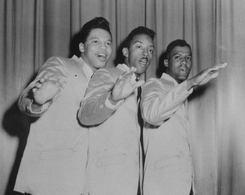-

The Jamies (Dorchester, Mass)
Personnel :
Tom Jameson
Serena Jameson
Jeannie roy
Arthur Blair
Discography :
1958 - Summertime, Summertime / Searching For You (Epic 9281)
1958 - Snow Train / When The Sun Goes Down (Epic 9299/9565)
1959 - Don't Darken My Door / The Evening Star (United Artists 193)
Biography :
The New York-based group derived its name from lead singer Thomas Earl Jameson, who wrote the song with the lyrics "Summertime, summertime/sum, sum, summertime" with Sherman Feller; the pair also collaborated on the flip side "Searching for You." The 45, released in 1958 on Epic, became one of the most popular summer songs of all time. It broke the Top 40 but stopped short of the Top 20 by six rungs at number 26, on September 22, 1958.
"Summertime, Summertime"'s follow-up, "Snow Train" (written by Feller) b/w "When the Sun Goes Down" (written by Jameson) failed to chart and slowed the Jamies' roll to a virtual stop. A switch to United Artists was hardly a panacea, as "Don't Darken My Door," written by Larry Jaspon and Vicki Gay, stiffed (along with the flip side, Jameson's "The Evening Star") in 1959.

The Jamies had numerous personnel changes: Robert Paolucci joined shortly after "Summertime, Summertime" hit, he became a monk afterward, but eventually left that calling to work as a translator. When they couldn't find another hit, the Jamies went to the well again with "Summertime, Summertime" and broke the Top 40 with it for the second time on August 4, 1962, at number 38.

A year later, the Fortunes (formerly the Cliftones) redid the song for their first release on Decca Records. But they weren't the only ones. The infectious ditty has also been redone by the Doodletown Pipers, Hobby Horse, Jan & Dean, the Legendary Masked Surfers, Mongo Jerry, and Sha Na Na. In addition, Buick and Applebee Restaurants both revitalized the song in their commercials. ~ Andrew Hamilton, Rovi
http://www.toddbaptista.com/the%20jamies.html
Songs :
Summertime, Summertime Snow Train Don't Darken my door
Searching for you Don't Darken My Door your comment
your comment
-
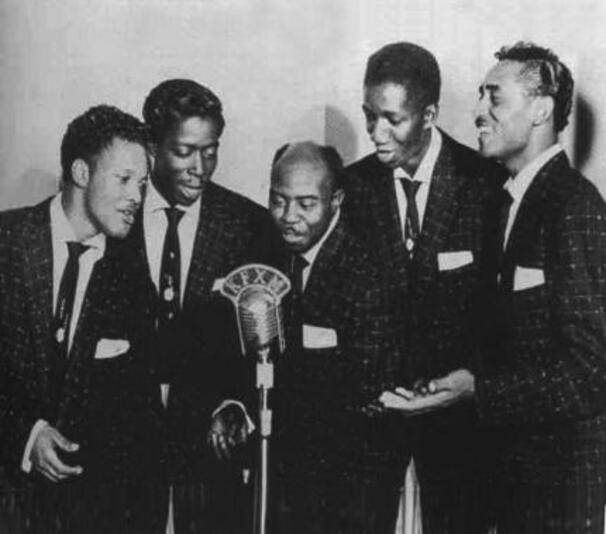
The Jewels (2) (Los Angeles)
aka The Marbles aka The RollersPersonnel :
Johnny Torrence (Second Tenor)
Rudy Jackson (Second Tenor)
Dee Hawkins (Tenor)
Vernon Knight (Baritone)
James Brown (Bass)
Discography :The Marbles
1954 - Golden Girl / Big Wig Walk (Lucky 002)The Jewels (2)
Singles:
1954 - Hearts Of Stone / Runnin' (R and B 1301)
1954 - A Fool In Paradise / Oh Yes, I Know (R and B 1303)
1954 - Rosalie / Living From Day To Day (R and B 1306)
1955 - Angel In My Life / Hearts Can Be Broken (Imperial 5351)
1955 - Natural Natural Ditty / Please Return (Imperial 5362)
1956 - How / Rickety Rock (Imperial 5377)
1956 - Goin', Goin', Gone / My Baby (Imperial 5387)
Unreleased:
N/A - Keep Your Feet On The Floor (Imperial)
N/A - One Night (Imperial)
N/A - No Shoulder To Cry On (Imperial)
N/A - Skid Row (Imperial)
N/A - Everybody Needs A Little Lovin' (Imperial)
The Jewels (2) (Second group)
1956 - She's A Flirt / B-Bomb Baby (RPM 474)
The Jewels (2) (Third group)
1959 - The Wind / Pearlie Mae (Antler 1102)
The Rollers
1961 - Got My Eye On You / Bonneville (Liberty 55303)
1961 - The Continental Walk / I Want You So (Liberty 55320)
1961 - The Bounce / A Teenagers' Waltz (Liberty 55357)
1962 - The Bug / Troubles (Bel Star 102)
Biography :
The Jewels (Originally a gospel group from San Bernardino) were a Los Angeles, California based group that, in 1953 and early 1954, recorded under the name The Marbles on the Lucky label. The band's line-up was comprised of performers who, with the exception of baritone Vernon Knight (who was added around the time the band changed its name), had 'jubilee'-style gospel music backgrounds.
Johnny Torrence, a tenor, was the band's leader; Rudy Jackson was lead singer; Dee Hawkins (tenor); James Brown (bass). The Jewels were named after group member Rudy Jackson's sister. During their first session for the R&B label the group cut Hearts Of Stone, a song co-written by Jackson (with Eddie Ray). While The Jewels' recording of the tune sold well on the West Coast, the version released by Otis Williams And The Charms on DeLuxe outsold the Jewels' record everywhere else. In 1955 R&B sold the group's contract to Imperial where they had three releases and then disbanded in 1956.


Torrence, however, formed another incarnation that recorded one single for the RPM label (She's A Flirt/B.Bomb Baby). Not much is known about this version of The Jewels other than the fact that Torrence was in the group along with another tenor named John, a baritone named Sam and a bass named Arthur Wilson.


The Third groupIn 1959, Johnny Torrence formed a third Jewels group, consisting of Don Sampson (lead), Johnny Torrence (second tenor), Willie Willingham (bass), Eddie Wilson (tenor), and his brother, Al Wilson (baritone). They recorded "The Wind" (not the Diablos' song) and "Pearlie Mae" for Buck Ram's Antler label. By 1961 Johnny Torrence had left the Jewels, leaving the remaining members of Al & Eddie Wilson, Don Sampson and Willie Willingham to re-brand themselves as "The Rollers".
http://www.uncamarvy.com/Jewels/jewels.html
http://home.earthlink.net/~jaymar41/jewels.html
Songs :
A Fool In Paradise Oh Yes I Know
Rosalie Please Return
No Shoulder To Cry On Hearts Of Stone
... your comment
your comment
-
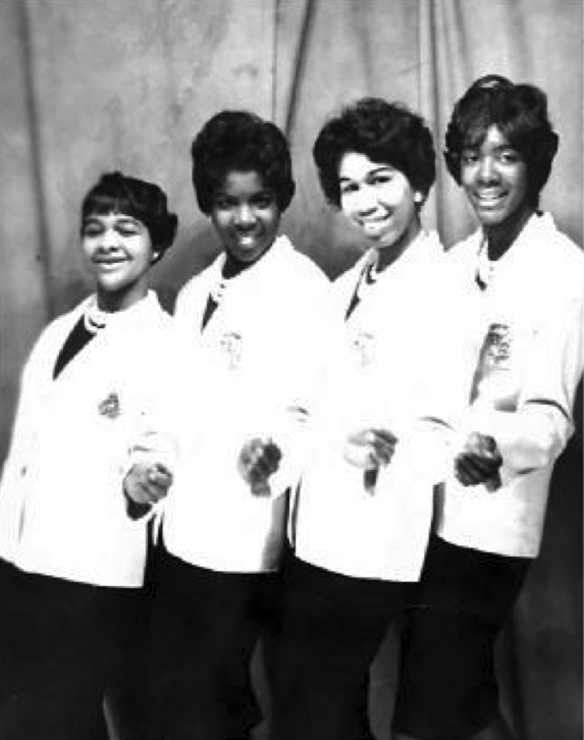
The Four Jewels (Washington, D.C)
aka The Impalas (3) aka The Jewels (5)
Personnel:Sandra Peoples
Margie Clarke
Carrie Mingo
Grace Ruffin
Discography :The Impalas (3)
1961 - For The Love Of Mike / I Need You So Much (Checker 999)The Four Jewels
1962 - Loaded With Goodies / Fire (Start 638)
1963 - Johnny Jealousy / Someone Special (Start 638)
1963 - All That's Good / I Love Me Some You (Start 641)
1963 - Dapper Dan / Loaded With Goodies (Checker 1039)
1964 - Time For Love / That's What They Put Erasers On Pencils For (Checker 1069)
1964 - Baby It's You / She's Wrong For You Baby (Tec 3007)The Jewels (5)
1964 - Opportunity / Gotta Find A Way (Dimension 1034)
1964 - This Is My Story / My Song (Federal 12541)
1965 - Smokey Joe / But I Do (Dimension 1048)
1966 - Papas Left Mama Holdin' The Bag / This Is My Story (Dynamite 2000)
Biography :
The Four Jewels formed at Roosevelt High School in Washington, DC. The group was first known as the Impalas. They changed their name to the Four Jewels. The Four Jewels consisted of Sandra Bears, Grace Ruffin, Margie Clarke and Carrie Mingo.
Along with other talented young singers out of Washington, DC, such as The Marquees (the first vocal group that Marvin Gaye sang with) and Billy Stewart, The Four Jewels would gather at the home recording studio of the legendary R&B singer, Bo Diddley, who then lived in Northeast Washington. In the early 1960s, Carrie Mingo left the group, and she was replaced by Martha Harvin (now known as Martha High). In 1964 the group released their first national hit "Opportunity" on the Dimensions label.


The Dimensions label was owned by rock and roll promoter, Don Kirshner. The song “Opportunity” stayed on the Billboard R&B charts for seven weeks.The Jewels have over 20 recordings, which have made an impact on the national and local R&B charts. Jewel’s member, Grace Ruffin, is the cousin of the legendary DC singer, Billy Stewart.


The Jewels The JewelsThe Jewels sing back up on the Billy Stewart song “Reap What You Sow”. They recently appear on the CD, The Velons & Their Divas (October 2007), where they sing new music written by Reese Palmer of The Marquees (which featured a young Marvin Gaye) (“Sugar Wooga Baby”), as well as a song penned by The Jewels (“Someone to Love”) In 1965, now The Jewels Impressed with The Jewels talents, Brown recruited the ladies to join him as part of the legendary “James Brown Revue”. The Jewels went on the road for one year with James Brown as his background singers. They appear on the song “Say It Loud, I’m Black and I’m Proud”. On the James Brown song “Don’t Be A Dropout”, James Brown calls out “The Jewels” during the song, and the Jewels recorded several songs produced by Brown, including “This Is My Story.”
http://www.myspace.com/thefabulousjewels your comment
your comment
-
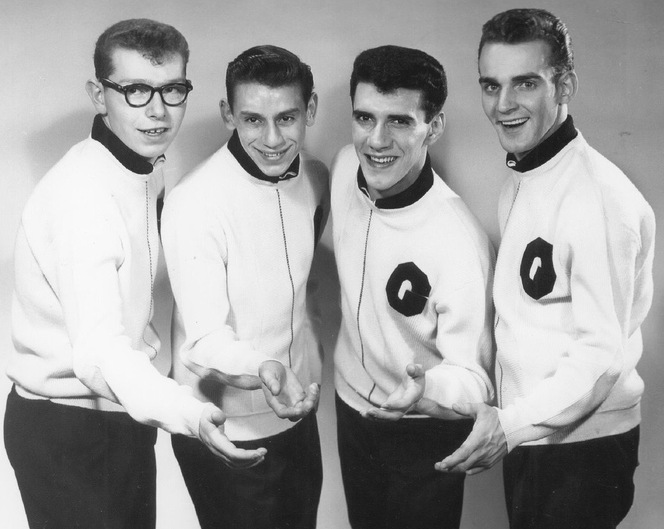
The Graduates (1) (Buffalo N.Y)
aka The Question Marks (2) ref The Playboys (4)Personnel :
John Cappello
Bruce Hammond
Fred Mancuso
Jack Scorsone
Discography:
The Playboys (4)
1957 - Don't Do Me Wrong / Why Do I Love You, Why Do I Care (Mercury 71228)The Graduates (1)
1959 - Ballad of A Girl And Boy / Care (Shan-Todd 0055)
1959 - What Good Is Graduation / Lonely (Corsican 0058)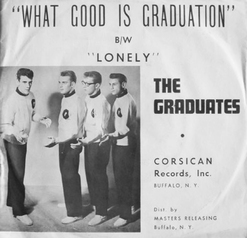
The Question Marks (2)
1959 - Ballad of A Girl And Boy / Concerto rock (Inst. by The Tune Rockers) (First 102)Johnny Holliday & The Graduates (1)
1963 - Goodbye My Love / Ballad Of A Boy And A Girl (Lawn 208)Biography :
In 1956, six guys decided to form a vocal group. They were frat members and high school students (mostly at Lafayette High School and Hutch Tech). Jack Scorsone, Ronald Page, Bruce,Hammond, Raymond Baunler, Harold Rogers and Anthony Mancuso called themselves The Rays. By 1957, they went to a Buffalo demo studio and recorded their one original song, Jack’s “Why Do I Love You, Why Do I Care”. Local DJ Frank Ward flipped when he heard it and immediately played it on the air. It got a great response so he called up somebody affiliated with Mercury Records, played it over the phone, and Mercury expressed an interest. A few days later the boys got an offer to come to New York City to record it. Two things happened as they set about recording - they learned of the already-existing Rays (soon to hit with “Silhouettes”) and had to come up with a name change.

The Playboys (4)A nearby copy of Playboy magazine gave them the inspiration. And they had to come up with a B-side. Jack Scorsone sat down and wrote “Don’t Do Me Wrong” off the top of his head. The group recorded it in two takes, with no chance to correct the couple bad notes that appeared! Back to Buffalo… the group was coming to grips with their whirlwind of success. In just a few short weeks they’d gone from demo to national label. Waiting for news of it they were asked to perform at a school assembly and were introduced as Recording Artists, to great adulation. And a few days later they started hearing “Why Do I Love You, Why Do I Care” on the radio.

Following the release of The Playboys' 45 membership changed and eventually settled into a lineup of Johnny Cappello, Bruce Hammond, Fred Mancuso and Jack Scorsone. They adopted a new name - The Graduates. DJs Tommy Shannon and Phil Todaro decided to issue a record on them, on their new label Shan-Todd (named for Shannon -Todaro). They'd previously hit with their first Shan-Todd release "Rockin' Crickets" by The Hot Toddys. The Graduates 1959 "Ballad of A Girl And Boy" came out as Shan-Todd 0055. Shan-Todd soon underwent a name change to Corsican Records, kept the same numbering sequence, in time for the next Graduates release ("What Good Is Graduation", also 1959).

They recorded this one at Buffalo Recording Service, scene of their first recording when The Playboys made a demo there. This time however it was a different group - John Cappello was now the lead vocalist. "Ballad of A Girl And Boy" made it on to the national Billboard Hot 100, at #74. The followup "What Good Is Graduation" did not make it onto the top charts, though it it hit the Bubbling Under The Hot 100 chart at #110. If there were local charts I'm sure these achieved Top Ten status, especially with the push the DJs behind the labels could give them. They were definitely played often on WKBW, a local station but one that reached far up and down the East Coast.
 1959 - (L to R) John Cappello , Jack Scorsone, Bruce Hammond and Fred Mancuso
1959 - (L to R) John Cappello , Jack Scorsone, Bruce Hammond and Fred Mancuso Whether they got properly paid for the records is anyone's guess. Standard procedure back then was that artists would recieve little royalties but could expect the make money with live appearances. Some big shows in father cities had to be cancelled when the still-young members couldn't get time off from school to travel! But the group apparently had their largest-paying show close to home, when they received the then-astronomical sum of $1500 for a show at Rochester's War Memorial Auditorium. With no real management, member Bruce Hammond handled the money and they all got paid.

With some shows, some TV appearances, nothing was breaking for them, and the group drifted apart. In 1963 a new single appeared on Lawn Records coupling "Goodbye My Love" with "Ballad Of A Boy And A Girl". Now credited to Johnny Holliday & The Graduates, apparently most of the group was not informed of its release until after the fact. "Goodbye My Love" is actually a retitled version of "What Good Is Graduation" making this single something of a reissue - merely compiling their two former A-sides.

Nothing much happened with this 1963 release, but it's then-dated sound couldn't really compete in the year 1963 with the coming invasion. That same year the Beatles 45 was released on Lawn's parent company Swan Records. An interesting and curious side-note is that many years later the group became aware of a mysterious record using their recordings. In 1959 a record was released on the First Records label, aka Another First, which contained "Ballad Of A Boy And A Girl" but now credited to The Question Marks. This seems to be an out take from the original Graduates sessions.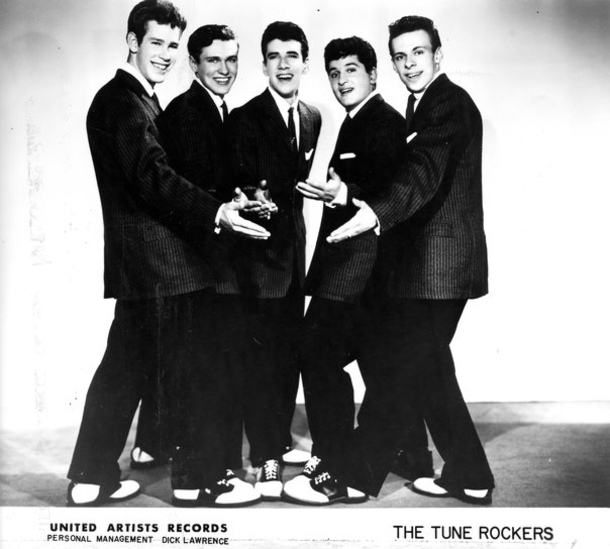
Johnny Cappello with the Tune RockersThe flip is also credited to The Question Marks but this is actually an out-take by The Tune Rockers ! Point of interest is that John Capello belonged to both groups, and Dick Lawrence - owner of First - had been involved in managing both groups. More interesting is the fact that the record doesn't seem to have been issued in an attempt to make a hit - the artists involved weren't informed, so there could be no promotion, and it was never distributed at all in their hometown!
https://wnyfm.wordpress.com/tag/the-playboys/Songs :
(updated by Hans-Joachim)The Playboys (4)
Don't Do Me Wrong Why Do I Love You, Why Do I CareThe Graduates (1)
Ballad of A Girl And Boy Care
What Good Is Graduation LonelyQuestion Marks (2)
Ballad Of A Girl And A Boy / Concerto Rock....
 1 comment
1 comment
-

The Vibranaires (1954) Clockwise from top : Bobby Thomas, Herb Cole, Roosevelt McDuffie, Mike Robinson & Jimmy Roache
The Vibes (1) (Asbury Park, New Jersey)
aka The Vibranaires
Personnel :
Bobby Thomas (Lead Tenor)
Roosevelt McDuffie (First Tenor)
Lenny Welch (Second Tenor)
William Penha (Baritone)
Joe Major (Bass)
Discography :
The Vibes (1)
1954 - Stop Torturing Me / Stop Jiving Baby ( Chariot 105)
The Vibranaires
1954 - Doll Face / Ooh, I Feel So Good (After Hours 103)
Biography :
Asbury Park, NJ-based R&B vocal group the Vibranaires formed in 1948. According to Marv Goldberg's profile in the September 1975 issue of Yesterday's Memories, the group was founded by lead tenor Bobby Thomas, a devout Orioles fan who modeled his vocals after the group's leader, Sonny Til. Baritone Herbie Cole (the nephew of drummer Cozy Cole), first tenor Ulysses Jackson, second tenor Albert Smith, and bass Willie Busby completed the original lineup, which at first operated as the Crooners. By 1950, only Thomas and Cole remained, with first tenor Roosevelt McDuffie, second tenor Mike Robinson, and bass Jimmy Roache filling the holes; Roache's amplified voice was reportedly so powerful it shook the walls, prompting a name change to the Vibranaires.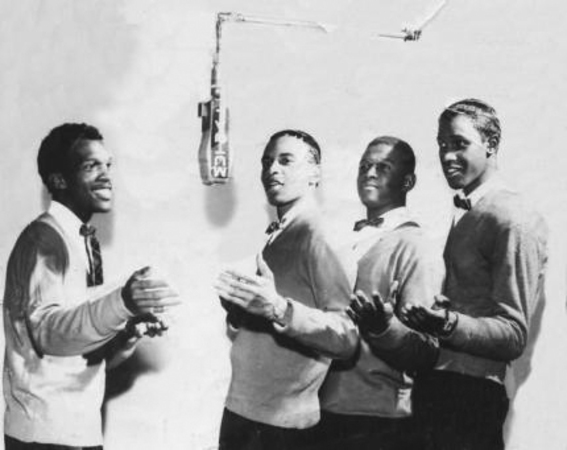
The Vibes (1956) L to R : Bobby Thomas, Lenny Welch, Joe Major & William Penha
For a short time in 1953 the group worked with manager and songwriter Esther Navarro, who insisted on another name change, this time to the Cadillacs -- a demo was recorded but when an official release failed to materialize, the Vibranaires terminated their partnership. In the meantime, the Vibranaires continued performing in New Jersey clubs, befriending Newark station WNJR DJ Joel Turnero, who in turn introduced the group to After Hours label owner Lexy "Flap" Hanford. On the eve of their first session for the label, Cole was arrested for stealing a bass guitar from a local club. He remained in jail while the remaining Vibranaires entered the studio, forcing them to create impromptu arrangements to work around his absence.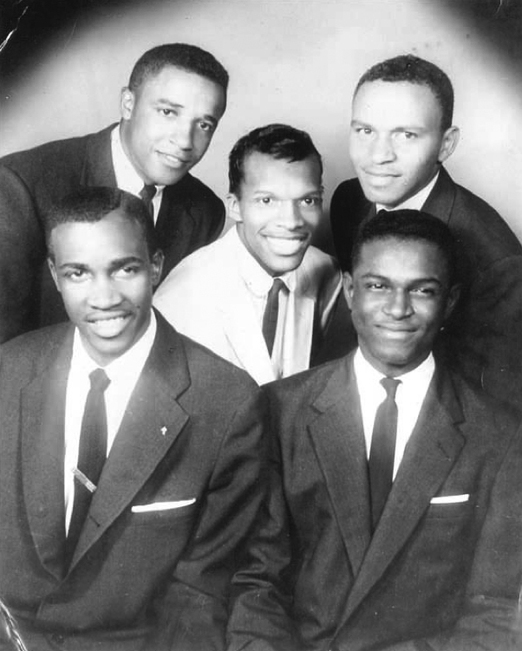
The Vibes (1956) Top L to R : Roosevelt McDuffie, Bobby Thomas, Lenny Welch Bottom L to R : William Penha & Joe Major
"Doll Face" appeared on After Hours in the summer of 1954, selling close to 40,000 copies in the face of minimal promotion. For the follow-up, "Stop Torturing Me," issued on Hanford's Chariot imprint, the group changed its name to the Vibes -- the shift may have resulted in the disc's disappointing sales, which prompted Hanford to cut them loose soon after. The Vibes rebounded by signing with promoter Bobby McNeil and touring the so-called "chitlin circuit" of black-owned nightclubs and theaters.
The Vibranaires (1964) - Top : Harry Accoo, Roosevelt McDuffie, Bobby Young - Bottom : Bobby ThomasRoache was drafted in 1955, setting off a series of personnel changes that included the brief inclusion of Lenny Welch, who notched the solo hit "Since I Fell for You" in 1963. When Thomas was also drafted for military duty in 1958, the Vibes finally called it quits, although he and McDuffie later reunited in the V-Eights. In 1966, Thomas' wish was granted -- he finally joined his beloved Orioles, touring with latter-day incarnations of the group for over three decades.
http://www.uncamarvy.com/Vibranaires/vibranaires.html
Songs :
The Vibes (1)
Stop Torturing Me Stop Jiving BabyThe Vibranaires
Doll Face Ooh, I Feel So Good...
 your comment
your comment
Doo Wop - Rhythm & Blues - Mail : jcpiazza26@gmail.com



